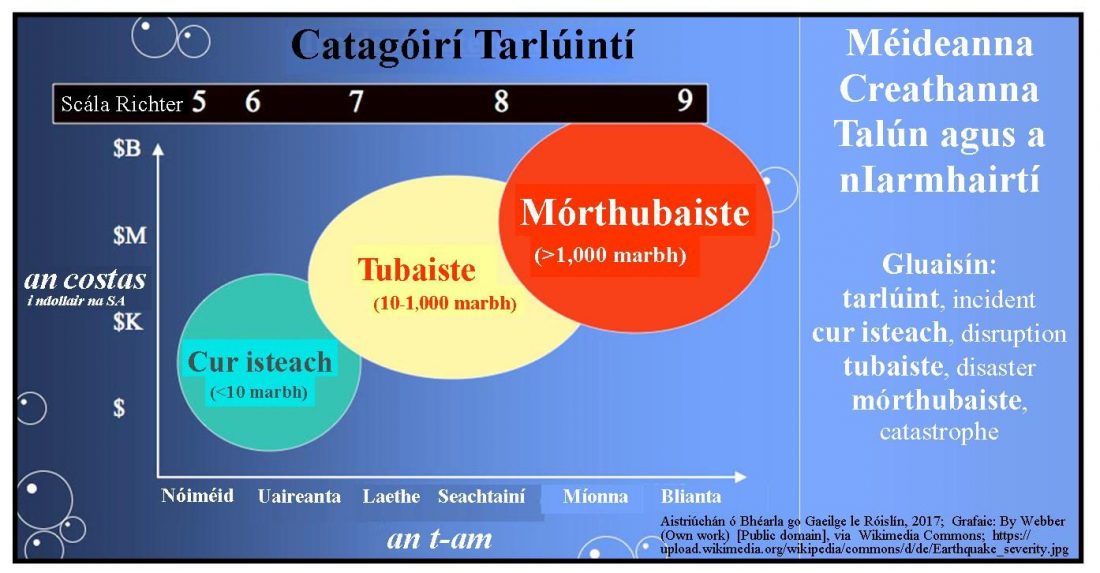Creathanna Talún (Earthquakes): Some Irish Words for Discussing Their Magnitude (Méideanna) and Impact (Iarmhairtí) Posted by róislín on Sep 20, 2017 in Irish Language
(le Róislín)
I note, with sadness, yet another tubaiste nádúrtha, the calamity in Mexico (an matalang i Meicsiceo).
You might remember that we dealt with creathanna talún earlier in this series (nasc thíos), when a “crith talún” struck the island of “Háítí.” That blogpost taught some of the relevant vocabulary for discussing creathanna talún, such as “an t-eipealár” and “an riosca seismeach” (mínithe thíos). An uair seo, ba é Meicsiceo a bualadh, go háirithe Cathair Mheicsiceo.
Today’s post presents an interesting graphic showing the impact of earthquakes in cost and time, according to their size on the Richter scale. Translating it into Irish was more challenging than I initially expected, since the English version makes a specific distinction between “disaster” and “catastrophe,” with “catastrophe” (over 1000 deaths) being worse than “disaster” (10 to 1000 deaths). But in Irish, most of the words for “catastrophe” can also be translated as “disaster,” so there’s no specific distinction. Therefore, this translation uses the traditional Irish pattern of adding an intensifier (in this case, “mór-“) as a prefix, making the third category (mórthubaiste) more extreme and intense than the second category (tubaiste).
Let’s take a closer look at these and some other words in the graphic:
First, “earthquake” itself, which is two separate words in Irish:
crith talún, an earthquake, lit. “quake / shiver / vibration / tremor of land”; gs: creatha talún, of an earthquake, creathanna talún, earthquakes
Next, some of the words used to create the chart:
catagóir, category, an chatagóir, gs: na catagóire, pl: na catagóirí
tarlúint, incident, an tarlúint, gs: na tarlúinte, pl: na tarlúintí
iarmhairt, effect, consequence, repercussion, and, sometimes, interestingly, aftershock/aftereffect, although in the strictly geological sense, that would be, quite logically, “iarchrith”; an iarmhairt, gs: na hiarmharta, pl: na hiarmhairtí
cur isteach, disruption, also and probably more commonly, “interruption” or “disturbance”; an cur isteach, gs: an chuir isteach; this phrase appears to have no plural. The genitive singular form, “an chuir isteach,” isn’t very widely used, in my experience, but it can show up in phrases like “le linn an chuir isteach” (during the …), “céim an chuir isteach” (the degree of the …), “de bharr an chuir isteach” (as a result of …), “i bhfianaise an chuir isteach” (in view of …), “uainiú an chuir isteach” (the timing of the …), “in aghaidh an chuir isteach” (against the …), and “íoslaghdú an chuir isteach” (“lessening the …). That pretty much accounts for all the samples I found online, a total of about ten, with a few duplicates.
tubaiste, disaster, catastrophe, calamity, tragedy, an tubaiste, gs: na tubaiste, pl: na tubaistí
mórthubaiste, major disaster, catastrophe, an mhórthubaiste, gs: na mórthubaiste, pl: na mórthubaistí. Pronunciation note: remember, the “t” is now silent, since it’s “lenited.”
Here are some additional words for “disaster,” but they don’t seem to be used so much in scientific contexts:
anachain, disaster, also calamity, harm, loss, mischance, trouble
matalang, disaster, also calamity or catastrophe
A few more ways to intensify “tubaiste” include “tubaiste amach is amach” (an “out-and-out” disaster) and “tubaiste gan aon agó” (lit. a disaster without any doubt / objection / condition”).
It’s also interesting to consider some other words for “catastrophe,” most notably “catastróf.” Seeing the obvious cognate, one might think that would be the best choice for the earthquake chart. But the Irish word “catastróf” is primarily used in discussing literature, especially Greek drama. It’s not unusual to find that a word that seems like an obvious cognate isn’t used in Irish as broadly as it might be in English; another example is “individual,” with the very Irish terms “aonair” or “ar leith” being typically used, but with the word “indibhidiúil” available for scientific or philosophical contexts like adaimh (atoms), tréithe (characteristics), or freagracht (responsibility).
Two more words for “catastrophe” are “eirleach” and “turraing,” but these are less applicable to our current project. “Eirleach” also means “carnage,” “slaughter,” “destruction,” and “havoc.” “Turraing” also means “attack,” “thrust,” “stumble,” “lurch,” and “electric shock.”
The ultimate take-away point for today’s blogpost? The basic term “crith talún” and a caveat that translating is rarely easy or straightforward. Almost every word has a range of meanings and the challenge is to pick the best one(s) for the specific purpose.
Má tá smaoineamh eile ar na haistriúcháin ag daoine ar bith ar an liosta seo, go mór mór, ag geolaithe ar bith a bhfuil Gaeilge acu, bheadh suim mhór agam a mbarúlacha a chluinstin. Dála an scéil, aon duine ó Mheicsiceo? Má tá, tá súil agam go bhfuil tusa is do mhuintir ceart go leor.
Tá súil agam go raibh an bhlagmhír seo úsáideach cé go bhfuil an dúbhrón orm gurbh ábhar smaoinimh reatha é. SGF — Róislín
PS: If you want to see the original graphic in English, it’s in Wikimedia Commons (nasc thuas, sa ghrafaic)
Mínithe na bhfocal “eipealár“ agus “riosca seismeach“: epicenter; seismic risk
Nasc: Tragóid i Háítí: An Crith Talún Posted by róislín on Jan 15, 2010 in Irish Language

Build vocabulary, practice pronunciation, and more with Transparent Language Online. Available anytime, anywhere, on any device.





Leave a comment: